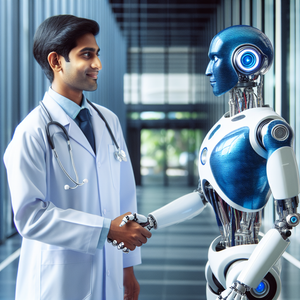The Hybrid Surgeon of 2053: A Vision of Seamless Collaboration Between Humans and Machines

The journey to the hybrid surgeon of 2053 has been shaped by decades of technological breakthroughs in healthcare. In the early 21st century, surgical robots like the da Vinci Surgical System began assisting surgeons with minimally invasive procedures, offering greater precision and control. Over time, these machines became more autonomous, capable of performing complex tasks with minimal human intervention. By mid-century, AI and robotics have evolved to such an extent that they can analyze patient data in real time, predict surgical outcomes, and execute procedures with submillimeter accuracy. However, the rise of machine intelligence has not diminished the surgeon's importance. Instead, the surgeon's role has shifted from being a manual operator to a strategic overseer and creative problem-solver. While machines excel at precision and data analysis, they lack the adaptability and intuition that humans bring to the table. For example, a surgical robot might flawlessly execute a routine heart bypass, but when faced with an unexpected complication—such as an anomaly in the patient’s anatomy—it is the hybrid surgeon who steps in to assess the situation, make quick decisions, and guide the operation to a successful outcome. The hybrid surgeon is, therefore, not just a practitioner but an innovator and leader, leveraging technology to enhance their capabilities. By combining the strengths of both human and machine, they embody a new standard of care that prioritizes safety, efficiency, and personalized treatment.
The Dynamic Partnership of Humans and Machines
At the heart of the hybrid surgeon's practice is a seamless partnership between human expertise and machine intelligence. This collaboration is not a hierarchical relationship where one side dominates but a dynamic interplay where each complements the other's strengths. Consider a scenario in which a patient presents with a rare and complex congenital condition requiring surgery. The AI-driven systems in the operating room analyze vast datasets of similar cases, identifying potential complications and recommending optimal surgical techniques. These machines can simulate various surgical approaches in real time, providing the surgeon with actionable insights. From there, the hybrid surgeon synthesizes this information, applying their own experience, intuition, and understanding of the patient’s unique circumstances to devise a customized surgical plan. During the procedure, this partnership becomes even more apparent. Robotic systems perform tasks requiring extreme precision, such as suturing microscopic blood vessels or excising tiny tumors, while the surgeon monitors the operation, ensuring everything proceeds smoothly. In moments of uncertainty—when the patient’s anatomy deviates from the expected or when unforeseen complications arise—the surgeon's adaptability and critical thinking come into play, guiding the technology to achieve the best possible outcome. This feedback loop between human and machine is the cornerstone of the hybrid surgeon's methodology. By delegating repetitive and precision-oriented tasks to machines, surgeons can focus on higher-order challenges, such as problem-solving and decision-making—areas where human expertise remains unparalleled.
The Value of Human Creativity and Empathy
While machines have revolutionized the technical aspects of surgery, they cannot replicate the uniquely human qualities of creativity, empathy, and emotional intelligence. These attributes are critical not only in the operating room but also in the broader context of patient care. For instance, before a procedure, a hybrid surgeon might meet with a patient to discuss their diagnosis and treatment options. While AI systems can provide data-driven recommendations, only the surgeon can interpret this information in the context of the patient’s values, fears, and long-term goals. A surgeon treating a cancer patient, for example, might use data to present multiple treatment paths while also considering the patient’s emotional state and quality of life. This human touch fosters trust, alleviates anxiety, and ensures that the care provided aligns with the patient’s needs and preferences. Post-surgical care also benefits from the surgeon's empathy and communication skills. A machine might monitor a patient’s vital signs and predict recovery timelines with incredible accuracy, but it is the surgeon who offers encouragement, addresses concerns, and provides reassurance during the recovery process. This blend of technical precision and compassionate care is what defines the hybrid surgeon’s practice, ensuring that medicine remains patient-centered even in an era dominated by technology.
Challenges and Ethical Considerations
The emergence of the hybrid surgeon raises important ethical and logistical questions. As AI systems take on more responsibilities in the operating room, accountability becomes a critical issue. If an AI-driven robot makes a mistake during surgery, who is held responsible—the machine's developers, the hospital, or the supervising surgeon? Establishing clear guidelines for liability is essential to maintain trust in these technologies. Another challenge lies in ensuring that AI systems are trained on unbiased and representative datasets. If these systems are trained on incomplete or skewed data, they may perpetuate health disparities, particularly in underserved populations. Hybrid surgeons must advocate for equitable healthcare practices, ensuring that technology serves all patients fairly. Additionally, the rise of automation could lead to concerns about the dehumanization of medicine. While machines can enhance efficiency, there is a risk that the patient experience could become more transactional and less personal. The hybrid surgeon must actively counteract this trend, using technology as a tool to enhance human care rather than replace it. To address these challenges, training programs for future surgeons will need to evolve. Aspiring hybrid surgeons must receive interdisciplinary education that integrates technical expertise with a deep understanding of medical ethics, sociology, and public policy. This holistic approach will prepare them to navigate the complexities of working alongside AI while maintaining their role as compassionate caregivers and patient advocates.
A Glimpse into the Future
The operating room of 2053 showcases the extraordinary potential of human-machine collaboration. Picture a surgical team composed of a hybrid surgeon, a suite of AI-driven robots, and augmented reality (AR) tools that provide real-time visualizations of a patient’s anatomy. The surgeon wears an AR headset that overlays critical data onto their field of vision, such as blood flow patterns and tissue density, enabling them to make informed decisions with unparalleled accuracy. Beyond the operating room, hybrid surgeons will play a pivotal role in research and education. By working with AI to analyze surgical outcomes and identify new techniques, they will drive innovation in medicine. They will also mentor the next generation of surgeons, teaching them not only how to use advanced technology but also how to think critically, empathize deeply, and act decisively in the face of uncertainty.
The hybrid surgeon of 2053 represents the perfect fusion of human creativity and machine intelligence. By leveraging the strengths of both, these professionals deliver healthcare that is not only more precise and efficient but also more compassionate and patient-centered. The hybrid surgeon is not a relic of the past but a pioneer of the future, redefining what it means to practice medicine in the age of AI. As we navigate the challenges and opportunities of this new era, one thing is clear: the future of surgery is not about replacing humans with machines but about creating a partnership where both can thrive. In this vision of the future, the hybrid surgeon is a symbol of progress, embodying the best that humanity and technology have to offer.
AI-Assisted Surgical Specialist
Major hospitals, surgical robotics companies (e.g., Intuitive Surgical, Medtronic)
Core Responsibilities
Oversee the integration of AI-powered surgical systems in operating rooms, ensuring seamless collaboration between human teams and machine tools.
Analyze real-time AI-generated data during procedures to optimize surgical outcomes and address unforeseen complications.
Develop and refine protocols for using autonomous surgical robots in both routine and complex operations.
Required Skills
Expertise in robotic-assisted surgery platforms (e.g., da Vinci, MAKO).
Proficiency in interpreting machine learning models and surgical data analytics.
Strong decision-making skills under pressure, with the ability to adapt to dynamic surgical environments.
Healthcare Data Scientist – Surgical Applications
Research hospitals, AI startups in healthcare, academic medical centers
Core Responsibilities
Design and train AI models to predict surgical outcomes and identify potential risks based on patient data.
Collaborate with surgeons to create machine learning algorithms tailored to specific procedures and patient populations.
Ensure datasets used for AI training are representative and unbiased to promote equitable care.
Required Skills
Advanced knowledge of AI/ML frameworks (e.g., TensorFlow, PyTorch) and healthcare data privacy regulations (HIPAA, GDPR).
Experience with medical imaging analysis and predictive analytics in healthcare.
Familiarity with surgical workflows and clinical needs to align technical solutions with real-world applications.
Augmented Reality (AR) Medical Specialist
AR/VR companies in healthcare (e.g., Brainlab, Osso VR), surgical device manufacturers
Core Responsibilities
Design and implement AR tools for real-time visualization of patient anatomy during surgical procedures.
Train surgical teams to use AR headsets and software for pre-surgical planning and intraoperative guidance.
Develop AR-based solutions that enhance precision and reduce surgical errors in high-complexity cases.
Required Skills
Expertise in AR platforms (e.g., Microsoft HoloLens, Magic Leap) and their application in medical imaging.
Strong understanding of human anatomy and surgical techniques.
Ability to bridge the gap between engineering teams and clinical practitioners in developing user-friendly interfaces.
Ethics and Policy Consultant – AI in Medicine
Government health agencies, healthcare consulting firms, medical ethics organizations
Core Responsibilities
Develop ethical guidelines and regulatory frameworks for the use of AI and robotics in surgical settings.
Address liability and accountability questions related to AI-driven decisions in patient care.
Advocate for equitable access to advanced surgical technologies, ensuring underserved populations benefit from innovation.
Required Skills
Deep knowledge of bioethics, healthcare policy, and AI governance.
Strong communication skills to engage with stakeholders, including tech developers, clinicians, and policymakers.
Experience in drafting legal and ethical frameworks for emerging medical technologies.
Clinical Educator for Hybrid Surgical Teams
Academic medical institutions, surgical training centers, professional organizations (e.g., American College of Surgeons)
Core Responsibilities
Train the next generation of surgeons to work effectively alongside AI and robotic systems.
Develop interdisciplinary curricula that combine surgical technique, AI literacy, and decision-making in high-tech environments.
Mentor surgical teams in leveraging technology while maintaining patient-centered care.
Required Skills
Background in surgical education with expertise in integrating technology into clinical practice.
Proficiency in emerging medical technologies, including robotics, AI, and AR.
Strong leadership and teaching skills, with the ability to inspire innovation and adaptability among trainees.


